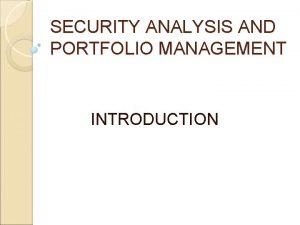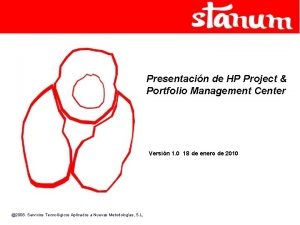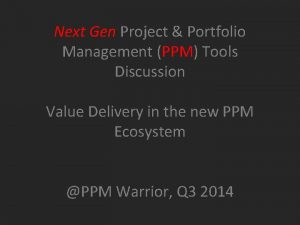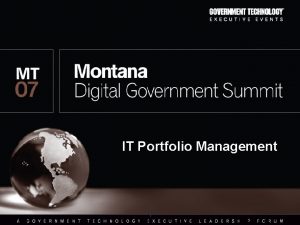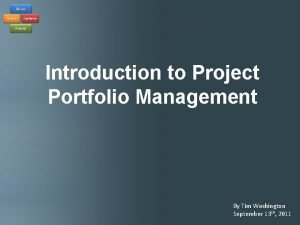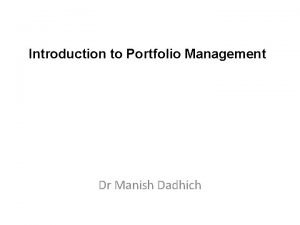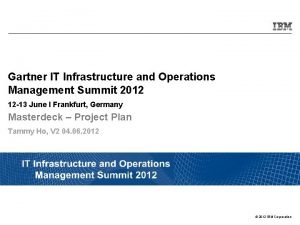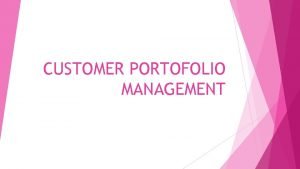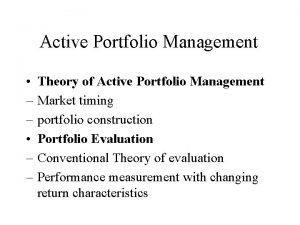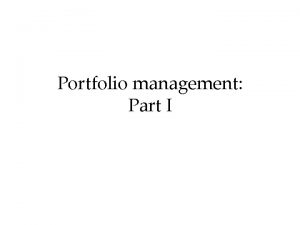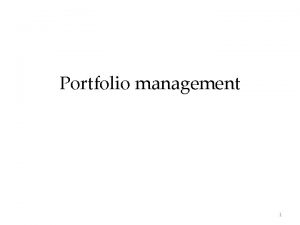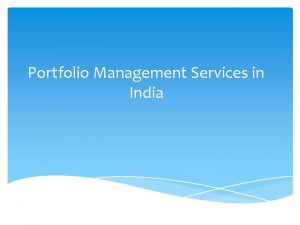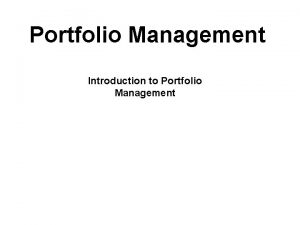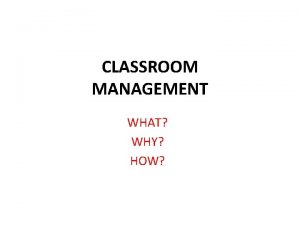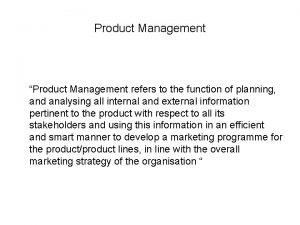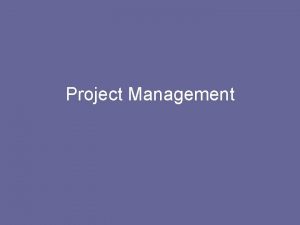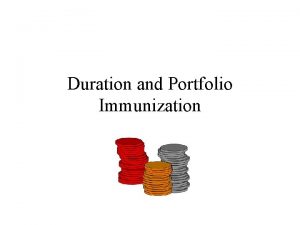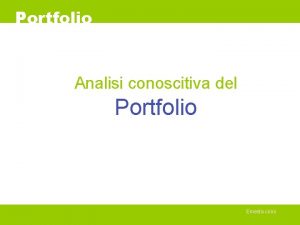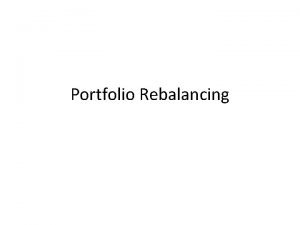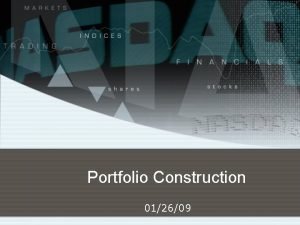Portfolio Management Portfolio A portfolio refers to a



















- Slides: 19

Portfolio Management

Portfolio A portfolio refers to a collection of investment tools such as stocks, shares, mutual funds, bonds, cash and so on depending on the investor’s income, budget and convenient time frame.

Portfolio Management • Portfolio management is all about determining strengths, weaknesses, opportunities and threats in the choice of debt vs. equity, domestic vs. international, growth vs. safety, and many other trade-offs encountered in the attempt to maximize return at a given appetite for risk. • In simple words, it refers to managing an individual’s investment in the form of bonds, shares, cash, mutual funds etc so that he/she earns the maximum profits within the stipulated time frame.

Who is a Portfolio Manager? • An individual who understands the client’s financial needs and designs a suitable investment plan as per his income and risk taking abilities. • A portfolio manager is one who invests on behalf of the client.

Key Responsibilities of a Technology Portfolio Manager • Manage and report on complete portfolio of technology projects across multiple lines of business • Interacts with business unit leadership to ensure business objectives are met and initiatives are prioritized appropriately • Partner with business and technology teams to report on portfolio and project health • Responsible for managing pipeline of small to large project requests and assigning proper resources

Key Responsibilities of a Technology P Manager • Prepares thorough and articulate executive summaries for senior leadership so that subsequent questions are not required • Participate and lead project checkpoints to ensure proper adherence to technology standards and procedures • Tracks project expenses with assigned project manager and ensure adherence to approved budget (as defined in approved business case) • Collaborates with Program/Project Managers to define time-frames, funding procedures, staffing requirements and assignment of resources

Key Responsibilities of a Technology Portfolio Manager • Develop internal controls and governance of SDLC standards by partnering with Technology PMO • Participate in defining requirements for project management tools, project budgeting, etc. • Prior experience working with onshore and offshore team, including working overlapping business hours to partner with onshore teams • Participate in leading capacity planning efforts across the technology organization • Provide coaching to Junior Associates and Associates • Works independently on complex projects

Need for Portfolio Management • Portfolio management presents the best investment plan to the individuals as per their income, budget, age and ability to undertake risks. • It minimizes the risks involved in investing and also increases the chance of making profits.

The Key Elements of Portfolio Management • Asset Allocation: seeks to optimize the risk/return profile of an investor by investing in a mix of assets that have low correlation to each other. • Diversification: is the spreading of risk and reward within an asset class. • Rebalancing: enables investors to capture gains and expand the opportunity for growth in high potential sectors while keeping the portfolio aligned with the investor’s risk/return profile.

Making a Technology Portfolio of an Organization The ultimate goal of a portfolio manager is to maximize the capabilities of the organization as a whole. A portfolio will help to show the area of interest relevant to a common industry specialty or domain. It can cover following areas: • Applications: The focus of the Applications portfolio includes: – – – What applications we currently have What applications are needed now and in the future Application 'health' How individual applications are architected Together with the other Enterprise Architecture portfolios how applications fit together within the broader environment

Making a Technology Portfolio of an Organization Business: It will focus on structuring and understanding business, information and technology patterns and how they work together to achieve strategic and tactical goals. It will address the following key areas: – Level of customers satisfaction, – Compete in the market, – Dealing with suppliers, – Sustain operations, and – Care for employees

Making a Technology Portfolio of an Organization Information: It will provide an enterprise view of the form and condition of the enterprise’s information and data assets. Building and maintaining information capability is done in collaboration with business stakeholders and colleagues within the enterprise including: initiative planning, project and service delivery teams. A the areas of concern could be: – The ease at which technology enables data and information to be created, accessed and transferred; – Emerging disruptive technologies; – Changing nature of user expectations, behaviours and mobility; and – The balance between protection and availability

Making a Technology Portfolio of an Organization Infrastructure: It is responsible for understanding the form and condition of the enterprise technology infrastructure. The focus of the Infrastructure portfolio includes: – – – What technologies we currently have, What technologies are needed now and in the future, Technology 'health', How technologies are architected, and Interrelationships and dependencies between technologies, and the applications and services they support. – Mobile/Digital and security aspects could also be included to make the technology profile more effective

Types of Portfolio Management • Active Portfolio Management: the portfolio managers are actively involved in buying and selling of securities to ensure maximum profits to individuals. • Passive Portfolio Management: the portfolio manager deals with a fixed portfolio designed to match the current market scenario.

Types of Portfolio Management • Discretionary Portfolio management services: the portfolio manager has full rights to take decisions on his client’s behalf. The individual issues money to the portfolio manager who in turn takes care of all his investment needs, paper work, documentation, filing and so on. • Non-Discretionary Portfolio management services: the portfolio manager can merely advise the client what is good and bad for him but the client reserves full right to take his own decisions.

Managing Technology Portfolio • Create an inventory of the technology portfolio: – Component Name and Vendor – Version or Model – Component Type – operating system, DBMS, development tool, etc. – Applications it Supports – Number of Users Supported – Amount Spent Per Year (labor + licensing + upgrades) – Sourcing – internal, hosted, cloud, etc. • Map technologies into their stages – In the Labs – Emerging from the Labs (early adopters) – Leading Edge – State of the Market – Last Generation – End of Life

Managing Technology Portfolio • Analyze the portfolio and act – How many users are they supporting and how much does it cost? – What is required to retire it and its related components? – Do you really need them or are they toys in someone’s toybox? – How will you know if they should be used in more core, mission critical applications in the future?

Managing Technology Portfolio • Create a process to review and refresh the technology portfolio – Does it make sense to consider the technology portfolio separately from the applications they support? – How much responsibility do we assign to our vendors in helping us identify and manage technology introduction and retirement? – Can the old age (and lack of skills, etc. ) or middleware component be enough to drive a major application change?

Seven Essential Steps in Portfolio Management 1. Originating Ideas 2. Conducting Research 3. Making Decisions 4. Structuring Transactions 5. Executing Transactions 6. Maintaining Investments 7. Exiting Investments
 Digital portfolio vs printed portfolio
Digital portfolio vs printed portfolio Working capital management refers to
Working capital management refers to What is gross working capital
What is gross working capital Top management middle management first line management
Top management middle management first line management Management pyramid
Management pyramid Basic concepts of management
Basic concepts of management Security analysis and portfolio management project
Security analysis and portfolio management project Security analysis and portfolio management project
Security analysis and portfolio management project Modern trends in project management
Modern trends in project management Project portfolio matrix
Project portfolio matrix What is the last level of pmmm?
What is the last level of pmmm? Hp project and portfolio management center
Hp project and portfolio management center Describe the steps in the portfolio management process?
Describe the steps in the portfolio management process? Nhs sharon hill
Nhs sharon hill Magic quadrant for project and portfolio management
Magic quadrant for project and portfolio management Gartner portfolio management
Gartner portfolio management Ppm tim washington
Ppm tim washington Introduction in portfolio example
Introduction in portfolio example Gartner portfolio management summit
Gartner portfolio management summit Customer portofolio
Customer portofolio







